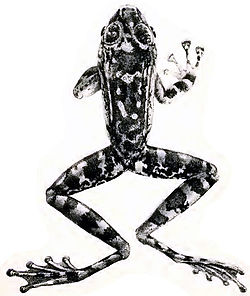| Amolops larutensis | |
|---|---|
 | |
| Amolops larutensis from Boulenger's species description (syntype) | |
| Scientific classification | |
| Kingdom: | Animalia |
| Phylum: | Chordata |
| Class: | Amphibia |
| Order: | Anura |
| Family: | Ranidae |
| Genus: | Amolops |
| Species: | A. larutensis |
| Binomial name | |
| Amolops larutensis (Boulenger, 1899) | |
| Synonyms | |
Rana larutensisBoulenger, 1899 | |
Amolops larutensis (common names: Larut sucker frog, Larut Hill cascade frog, southern pad-discked frog) is a species of frog in the family Ranidae that is found in the Malay Peninsula from southernmost Thailand to Malaysia; records further north probably represent A. panhai . [2] [3]
